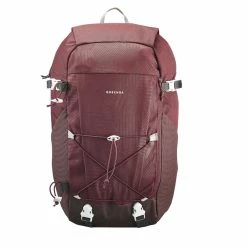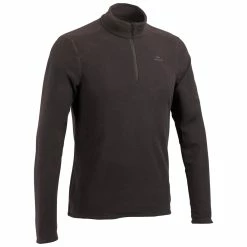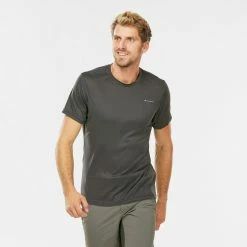Discount ⭐ Forclaz Trek 900, 32°F Feather/Down Camping Mummy Sleeping Bag ✨
$199.00 Original price was: $199.00.$91.99Current price is: $91.99.
- Experience the Best Quality
- The quality you expect, the service you deserve.
- The best quality products, always.
- Safe Transactions, Happy Customers

Sleeping bag 32°F in feather (down, 800 cuins): high-end. 2.1 lbs in size L: warm, light, compact. Mummy shape, yet comfortable. Ergonomic hood. Zipper with double slider. Water-repellent.
Designed in the French Alps, this RDS* certified feather sleeping bag is suitable for sleeping comfortably at temperatures above or equal to 32°F/0°C
Temperature of use:
All our sleeping bags display the temperature ratings, tested by an independent laboratory (AITEX), in accordance with the European standard NF ISO 23537 – 2017.
The “comfort temperature” is the lower comfort limit at which a user in relaxed position is in overall thermal balance and is neither hot nor cold (determined for an average woman in normal conditions of use). Choose your sleeping bag according to this criterion.
What are the limit temperatures for usage?
Limit temperature: temperature limit at which the user of the sleeping bag in huddled-up position is generally in thermal equilibrium and is neither cold nor hot (determined for a standard man under normal conditions of use). We recommend using an insulation mattress to optimize your thermal comfort.
This sleeping bag is filled with feathers and down. The thermal insulation may drop in damp conditions.
However, this is what you need to know about temperatures:
A sleeping bag does not produce heat but retains the heat produced by the body. If you are tired and cold and you slip inside a cold, damp sleeping bag, it is very likely that you will feel cold no matter how good your sleeping bag is! These temperatures therefore depend on the person’s resistance to cold (bulk, fatigue, etc.), equipment (mattress with insulation, etc.), clothing (naked, underwear, etc.), and weather conditions (humidity, wind, etc.).
For greater comfort, before getting into your sleeping bag:
Dress simply (1 layer of clothing is enough) Warm up your extremities: Use hats, gloves, socks, bed warmers, rubbing, etc.
A flask filled with hot water can be used as a foot or bed warmer (so long as there’s no chance of it opening by accident!)
Contract your muscles (70% of the energy consumed is converted into heat) but without making any movement generating a cold airstream. Use a silk or thermal sleeping bag liner to maximize warmth and hygiene inside your bag.
Shape:
The mummy shape optimizes thermal insulation (no loss of heat because there is not much air flow or drafts) and saves space, which means that your movements are restricted.
Width at the shoulders 28.3″, height at the feet 10.2″ in size L.
Ergonomic hood with drawstring.
Double slider, lined with an anti-cold duvet flap, side opening.
H-shaped compartment structure to reduce thermal bridges.
Weight and dimensions:
Size S 1.7 lbs, user height: up to 5’3″. Bag dimensions: Ø 5.9″ x 13.4″. 6.1 liter volume. Weight 13.4 oz down.
Size M 1.9 lbs, user height: 5’3″ to 5’7″. Bag dimensions: Ø 6.3″ x 13.4″. 6.9 liter volume. Weight 15.5 oz down.
Size L 2.2 lbs, user from 5’7″ to 6′ tall. Bag dimensions: Ø 6.7″ x 13.4″. 7.8 liter volume. Weight 1.1 lbs down.
Size XL 2.3 lbs, user between 6’1″ and 6’7″ tall. Bag dimensions: Ø 7.1″ x 13.4″. 8.7 liter volume. Weight 1.2 lbs down.
Size and thermal insulation:
Try your sleeping bag before buying it to choose the right size for your comfort. Ideally, you should not be pressed up against the fabric, at the feet or head, and the fabric should not be taut. This would create thermal bridges that lower the insulation of your sleeping bag. Conversely, a sleeping bag that is too big will be harder to heat up and will not be as good at insulating the heat generated by the body.
Size and thermal insulation (continued):
The weight, volumes, and sizes may vary slightly owing to production tolerances.
Volume and dimensions in the bag may vary according to the compression applied to the product.
Origin of feathers and RDS certification:
Our traceability system lets us guarantee the origin of the feathers in accordance with our commitment to use responsible materials. Our suppliers are committed to using only feathers that come from ducks (Chinese origin) that are bred for their meat and are plucked after slaughtering.
We have been awarded RDS certification (Responsible Down Standard) by a 3rd-party organization.
http://sustainability.decathlon.com/media-reports/
The advantages of a duck down and feather fill:
The fill power of down has 3 advantages for mountain sports:
– Thermal insulation provided by the air trapped in the down and feathers
– Ultra low weight: Down is lighter than synthetic fill while offering the same degree of warmth. This saves even more weight in your backpack
– Ultra-compressible
How to measure the fill power of a down and feather fill?
The fill power is a measure of the down’s thermal insulation capacity and its potential to “trap” air. It is expressed in CUIN (cubic inches).
So, down with a higher fill power (higher CUIN number) will occupy more space, trap more air, and provide greater thermal insulation.
90% duck down, 10% duck feathers.
Filling Power of the down: 800 CUIN (IDFB standard)
The feather filling requires special care. Follow care advice.
Care instructions
Machine wash on a delicate cycle at 86°F, wash inside out, with 3 or 4 washing balls (or clean used tennis balls). Use a detergent for feathers and down. Rinse multiple times. Spin dry on a slow and gentle cycle. Required step: Tumble dry on low heat on a delicate cycle. Finish off drying outside, ideally in the sun, on both sides to prevent the down from forming clumps. Dry thoroughly before storing.
Eco-design
We chose to use a so-called “biton” thread for all the gray-colored fabrics in this sleeping bag.
Textile dyeing requires a lot of water but also produces waste water from the dye baths. To reduce this impact on the environment, we chose to use a dyeing process called “bi-ton,” which involves dyeing 1 in every 2 yarns. This dyed yarn is also made from a bulk dyeing process that incorporates the color pigments from the yarn manufacturing phase onward.
Warranty:
We have chosen to use a “biton” yarn in the sleeping bag lining (gray).
Textile dyeing requires a lot of water but also produces waste water from the dye baths. To reduce this impact on the environment, we chose to use a dyeing process called “bi-ton,” which involves dyeing 1 in every 2 yarns. This dyed yarn is also dyed using mass pigmentation, using color pigments when the yarn is manufactured.
Composition
Filling : 90.0% Grey duck down, Filling : 10.0% Grey duck feather
Lining : 100.0% Polyamide
Main fabric : 100.0% Polyamide
Carry bag : 85.0% Polyester cationic, Carry bag : 15.0% Polyurethane
Bag cover : 100.0% Polyester cationic
Optimal temperature : Comfort temperature 32°F/0°C, limit temperature 23°F/-5°C
Easy to transport : 2.1 lbs in size L. 7.8 liter volume. 2 bags: stuff bag and storage bag.
Sleeping comfort : Comfortable mummy shape, ergonomic hood. Long zipper with double pull.
Water repellent : Water-repellent fabric to optimize the thermal performance of your sleeping bag.
Warmth : RDS ethical down and feathers with a fill power of 800 CUIN.
Compatibility : non-twinnable sleeping bag
| Color | Orange |
|---|---|
| Size | M, L, XL |
Be the first to review “Discount ⭐ Forclaz Trek 900, 32°F Feather/Down Camping Mummy Sleeping Bag ✨” Cancel reply
Related products
Camp Furniture
Camp Furniture
Hiking Clothing
Hiking Clothing
Cheap 🥰 Quechua MH100, Short Sleeved Hiking T-Shirt, Men’s 👍
Hiking Clothing
Discount ❤️ Hiking Clothing Quechua SH100 U-Warm, Waterproof High Snow 🥾 Boots, Men’s ⌛
Hiking Clothing

































































Reviews
There are no reviews yet.